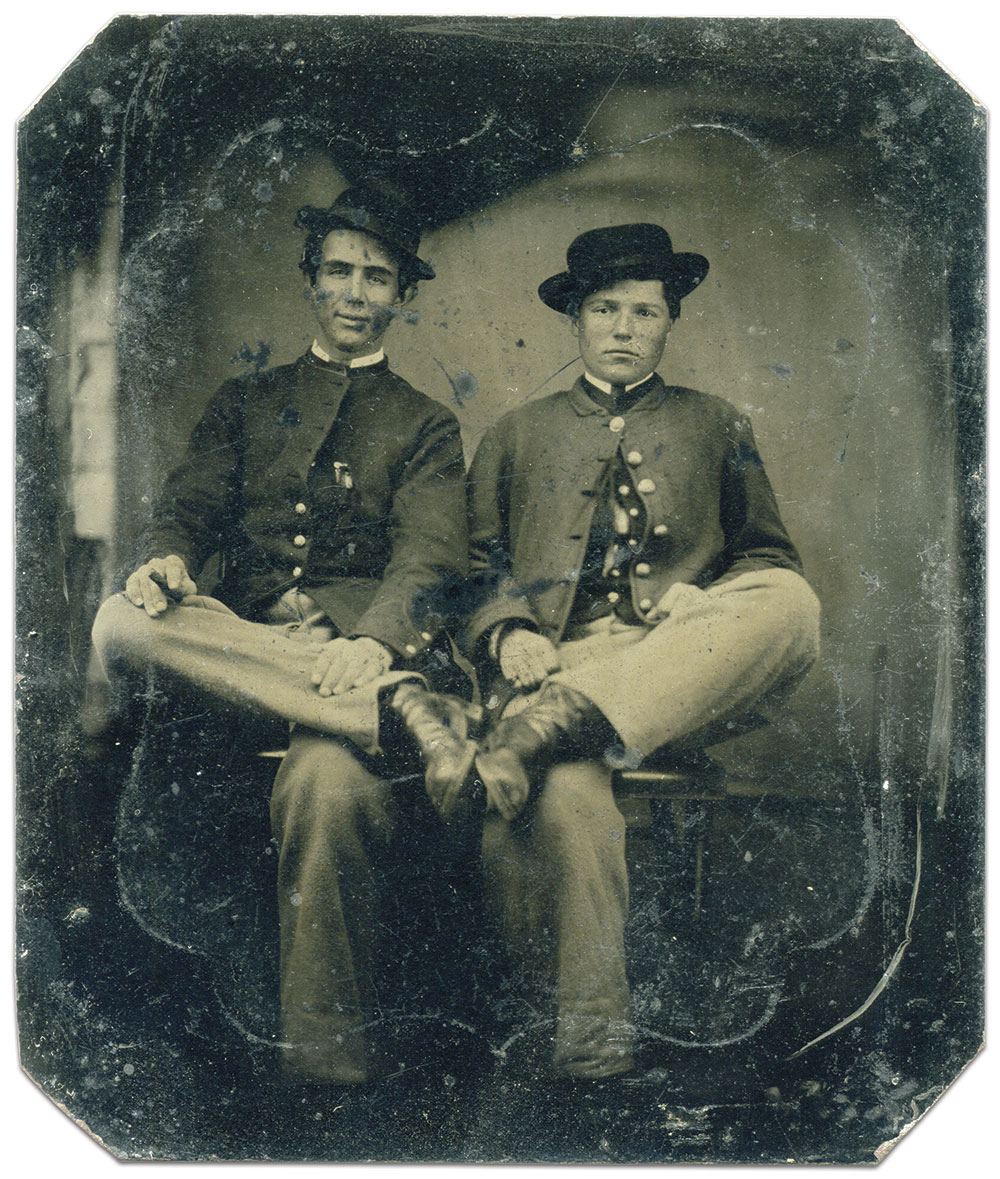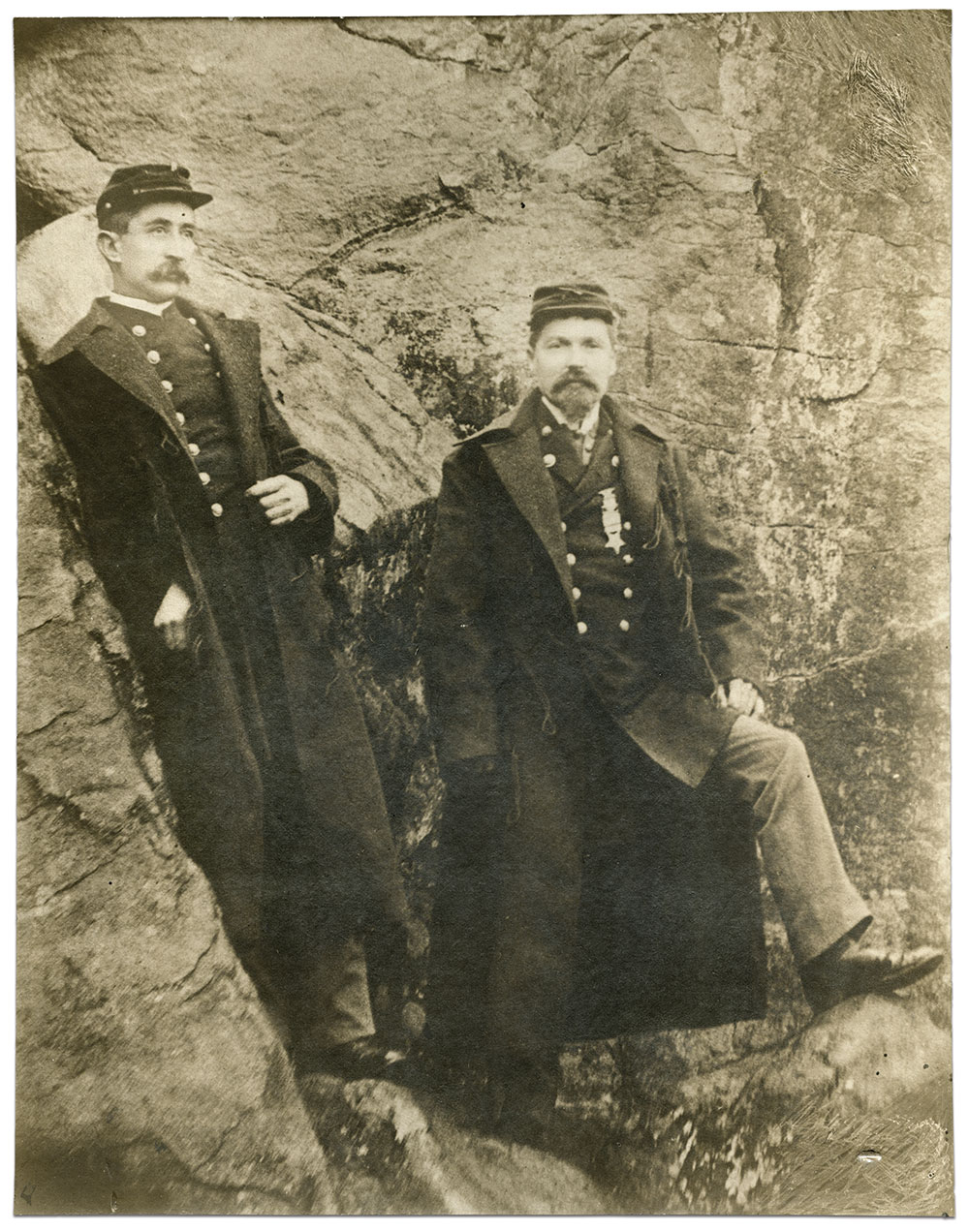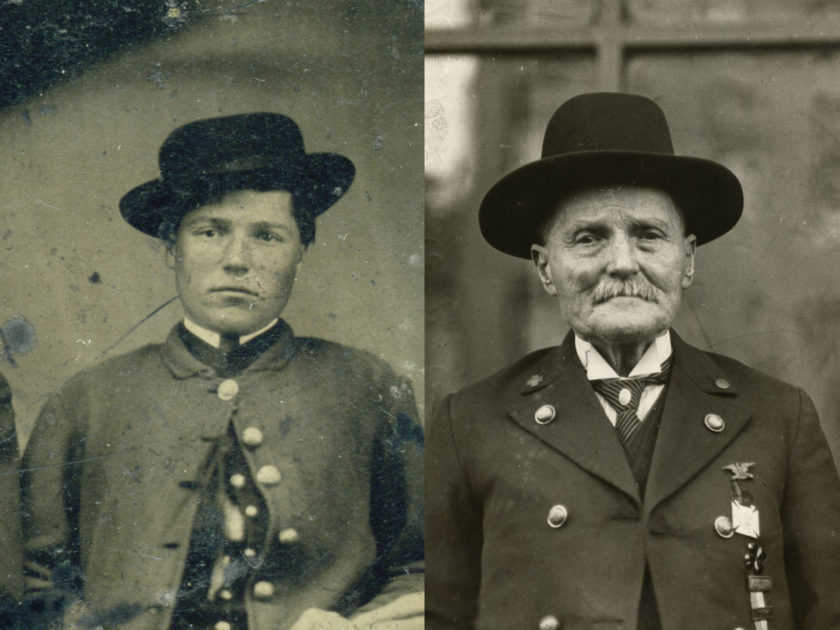By Stephen R. Bockmiller
Few veterans are known to have served in any uniformed role in the Civil War and World War I. Among this limited cadre is George Leonard Fisher.
Although his passing in 1927 made the news in his adopted hometown of Hagerstown, Md., his record and a rich photographic legacy that spans both conflicts had largely gone unnoticed.
Born Nov. 20, 1846, in the Kingdom of Bavaria to George N. and Barbara (Hachtell) Fisher, George emigrated through the port of Baltimore in 1854, having arrived from Bremen aboard the ship Weser. The Fishers settled in the remote farming community of Buck Valley in Fulton County, Pa.

Fisher left home in August 1862 and joined the fight to preserve his adopted country. He crossed over the Maryland border into adjacent Washington County and enlisted in Company A of the 7th Maryland Infantry at Hagerstown. Just three months shy of his 16th birthday, he listed his occupation as carpenter.
The boys of Company A had the good fortune of deploying in their own community. Assigned to the 8th Army Corps, it, and the rest of the regiment, became part of the famed Maryland Brigade. Brig. Gen. John Reese Kenly, an attorney and Mexican War veteran, commanded the force. The brigade trained in Baltimore and missed the Battle of Antietam. From Sept. 20, 1862, until the following June, the 7th spent a relatively quiet existence as a garrison force in Washington County, protecting the important transportation lines of the Chesapeake and Ohio Canal, and Baltimore and Ohio Railroad.
On June 1, 1863, Fisher’s service record was blemished for the first and only time in his long military career. He and several of his comrades were accused of engaging in a “riot” in Bolivar, Va. The provost arrested Fisher and three others, and tossed them in the guardhouse in Harpers Ferry. According to a diary kept by one of the provost, a court martial took place two days later, though no verdict was recorded.
Meanwhile, Gen. Robert E. Lee’s Confederates crossed into Maryland as part of the second invasion of the North. Eighth Corps units pulled back from Washington County to Frederick, Md., and took up station there during the Battle of Gettysburg. After the engagement, as the defeated Confederates made their way back to Virginia, victorious Maj. Gen. George G. Meade solidified his lines along the Sharpsburg Pike opposite Lee’s Williamsport defenses. On July 10, the Maryland Brigade reinforced the 3rd Division of Maj. Gen. John Newton’s First Corps. Two days later, the brigade engaged in a skirmish at Funkstown.
“I was forced to sleep in a hole dug in the ground.”
Fisher and the rest of the brigade settled into a predictable military routine until the following spring, with the exception of the October 1863 Bristoe Campaign.
In March, 1864, the Marylanders joined the 2nd Division of Maj. Gen. Gouverneur K. Warren’s 5th Corps and marched into the Overland Campaign. They shared the same bloody history as the rest of Warren’s veterans: The Wilderness, Todd’s Tavern, Laurel Hill, Spotsylvania, Harris Farm, North Anna, Cold Harbor, Bethesda Church, the first assault on Petersburg and Weldon Railroad. Fisher numbered among the fortunate to emerge unscathed.
His luck soon changed.
Fisher and five of his compatriots fell into enemy hands when their picket line was overrun near Weldon Railroad on Sept. 16, 1864. The event appears to be associated with the “Beefsteak Raid,” a Confederate movement by Maj. Gen. Wade Hampton and 3,000 troopers to capture Union cattle for Lee’s hungry soldiers.
After a week in Richmond at Libby Prison, Fisher spent three more weeks at the prison camp in Danville. Then, he was sent onto his final point of captivity at Salisbury, N.C. Fisher noted years later, “I was forced to sleep in a hole dug in the ground.”
Fisher marked his 18th birthday as a prisoner of war at Salisbury. When the camp closed in February 1865, he and other able-bodied prisoners were sent to Wilmington, and exchanged on March 1. He rejoined the 7th and mustered out with his regiment at Arlington Heights, Va., on May 31, 1865. Fisher returned to Hagerstown a hardened combat veteran still six months short of his 19th birthday.

A year later, in July 1866, Fisher resumed his military life as a private in Company A of the 2nd U.S. Infantry for a three-year term. He joined the regiment at Crittenden Barracks in Louisville, Ky., and remained in Kentucky for the majority of his enlistment. While in the Bluegrass State, he married Irish immigrant Margaret Handley on Nov. 6, 1867. A son, George Michael Fisher, was born in 1868.
In April 1869, the 2nd was ordered to south Georgia. The regiment’s deployment at the height of Reconstruction occurred weeks before the expiration of his enlistment. By the time Company A arrived in Georgia, Fisher had been promoted to first sergeant of his company. The 2nd spent its time as a garrison force, maintaining order, enforcing election and reconstruction laws, and assisting U.S. Marshals and revenue collectors.
Fisher spent another decade in the regular army, most of it in Southern posts. During this time his family grew by two, a son, Thomas L., who died in infancy, and a daughter, Mary Barbara.
In July 1877, the regiment moved to Idaho Territory in response to hostilities erupting with the Nez Perce tribe led by Chief Joseph. Fisher and Company A arrived in Lewiston, and spent the next four months on campaign around the Pacific Northwest. The 2nd spent the winter at Fort Lapwai, 10 miles east of Lewiston. In the spring of 1878, Company A and three other companies headed for Coeur d’Alene Lake on the Spokane River, and began construction of Fort Cour d’Alene, later renamed Fort Sherman. A historical sketch of the regiment described it as “the most beautifully situated post in the country.”
In July 1879, Fisher declined a fourth enlistment, and was discharged from the army at Fort Coeur d’Alene. Now in his 30s, with a wife and two children, he moved his family to Hagerstown.

By all accounts, Fisher made a smooth adjustment into civilian life. He worked at the Cumberland Valley Railroad’s Hagerstown Depot; joined a church and several social fraternities; and volunteered in the local hook and ladder company. He served as a mentor and instructor to a local boys’ military drill club, and as a scoutmaster to Washington County’s first troop of the Boy Scouts of America. Active in the Grand Army of the Republic, Fisher served a term as commander of the Jesse Reno Post #4, and was Junior Vice Commander of the Department of Maryland.
He also enlisted in the Hagerstown Light Infantry. A new company of the Maryland National Guard, it was formed by former Confederate major and Stonewall Jackson staffer Henry Kyd Douglas. Fisher received a lieutenant’s commission in 1888. The company was renamed the “Douglas Guards” in 1894 to honor its founder.
Four years later, the company mobilized for service in the war with Spain, with Fisher as its captain and commander. The Guards mustered into the 1st Maryland Volunteer Infantry as Company B at Pimlico Race Course in Baltimore on April 25, 1898. The regiment included veterans and offspring of the Blue and the Gray. Fisher’s company included Pvt. Charles R. Atzrodt, the nephew of the Lincoln conspiracy figure. The Marylanders spent less than a year on duty, and made it only as far as Georgia before being mustered out in February 1899.

Company B returned to Hagerstown and resumed its role as “hometown soldiers.” Fisher earned the distinction of being considered the most efficient company commander in the regiment. In 1908, he became the first charter member of Hagerstown’s Joseph C. Byron Post #3, United Spanish War Veterans. He later served as commander of this post.
Fisher retired from the Maryland National Guard in January 1911. But he would heed the nation’s call to arms one more time.
As the entire national guard mobilized and packed off for Europe in August 1917, the state government formed the “Maryland State Guard,” a deep reserve force that carried out the domestic responsibilities of the Maryland National Guard, while it fought in the trenches of France. This body exists today as the “Maryland Defense Force.”

The 71-year-old captain came out of retirement to serve as a drill instructor for the State Guard. In doing so, he became one of the few Civil War veterans who served in any uniformed capacity during the Great War. He also participated in local Liberty Loan campaigns.
The war hit the Fisher family hard when it learned that his son-in-law, Capt. James Malcolm McKibbin, an army doctor in the 77th Division, had suffered a mortal wound at Chevieres, France, during the last month of the war. McKibbin lost his life during an attempt to rescue a wounded soldier trapped between the lines, and posthumously received the Distinguished Service Cross.
Not one to rest upon his laurels, Fisher performed one last mission in the service of his country. On May 14, 1927, he was appointed the 14th Superintendent of Antietam National Cemetery—the last Civil War veteran to serve in this post. But the posting appears likely a largely administrative, or ceremonial appointment, as he was 80 years old and feeble.
On a December day in 1927, Fisher took a tumble on the streets of Sharpsburg and retired to his home. He died on Christmas Eve. The Hagerstown press widely covered his passing. Numerous memorials appeared in local newspapers. One of his men saluted his captain with a touching tribute. “The Captain was more than a soldier. His long service in that line, his sacrifice to his country, his efficiency, his loyalty, all attest to him as a good soldier. But I know him as a man—as a Christian! In service, in camp, he was like a father to us. There was no gulf between the officer and the private. Many a time when we were relieved from duty for a little recreation he would admonish us to remember our uniform and the flag, and not to do anything that would besmirch the soldier or drag the flag in dishonor.”

The soldier’s rest finally came, not in the National Cemetery that he served in his final days, but in the community in which he was raised. He was laid to rest at the Buck Valley Zion Lutheran Church in Fulton County next to Margaret and Thomas.
Special thanks to Kirk Fisher, the great-great grandson of George L. Fisher.
Special note: The entire collection of Fisher’s miltiary photos will be available on the Antietam National Park’s website by the release of this issue. The collection and other artifacts related to Fisher’s Civil War and Spanish-American War service will be on display at the Newcomer House Visitor Center, Antietam Battlefield, on Sept, 17, 2017, the 150th anniversary of the dedication of the cemetery.Visit heartofthecivilwar.org and nps.gov/anti for details.
References: George L. Fisher pension file, National Archives, Washington, D.C.; Annual Report of the Adjutant General of Maryland; Diary of Daniel Trittle, Co. A, 7th Maryland Infantry, copy in author’s possession; “Soldier’s Record” of George L. Fisher, in possession of descendants; Theophilus F. Rodenbough and William L. Haskin, The Army of the United States: Historical Sketches of Staff and Line With Portraits of Generals-in-Chief; Hugh Ridgely Riley, Roster of the Soldiers and Sailors Who Served in Organizations from Maryland During the Spanish American War; Hagerstown newspapers collection.
Stephen R. Bockmiller, AICP, is a life-long 19th century and local history enthusiast. A native of Baltimore, Md., he manages the City of Hagerstown’s Civil War tourism efforts around his “real” job as the city’s development planner and zoning administrator. He has authored three books on Hagerstown/Washington County Civil War history, co-authored two books on the Constellation with Lawrence J. Bopp, and serves on Constellation’s Advisory Board. He lives with his wife Stefania and daughter Sarah near Waynesboro, Pa.
SPREAD THE WORD: We encourage you to share this story on social media and elsewhere to educate and raise awareness. If you wish to use any image on this page for another purpose, please request permission.
LEARN MORE about Military Images, America’s only magazine dedicated to showcasing, interpreting and preserving Civil War portrait photography.
VISIT OUR STORE to subscribe, renew a subscription, and more.

